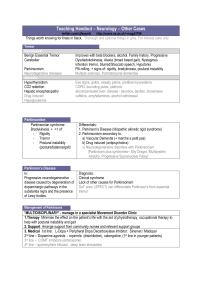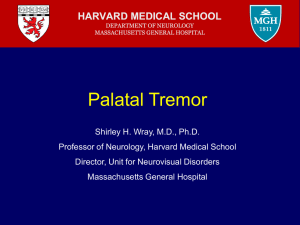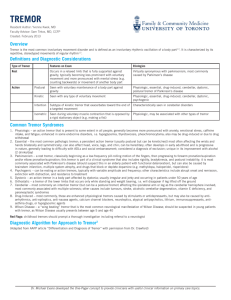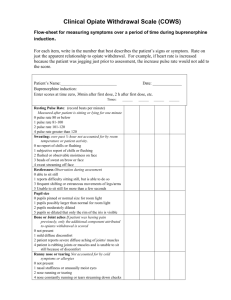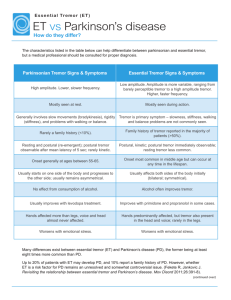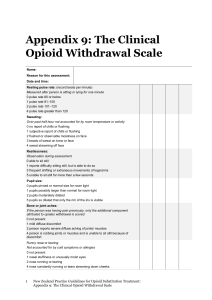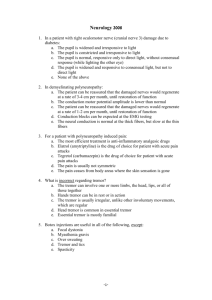Tremors: Causes & Remedies - Probility Therapy Services
advertisement
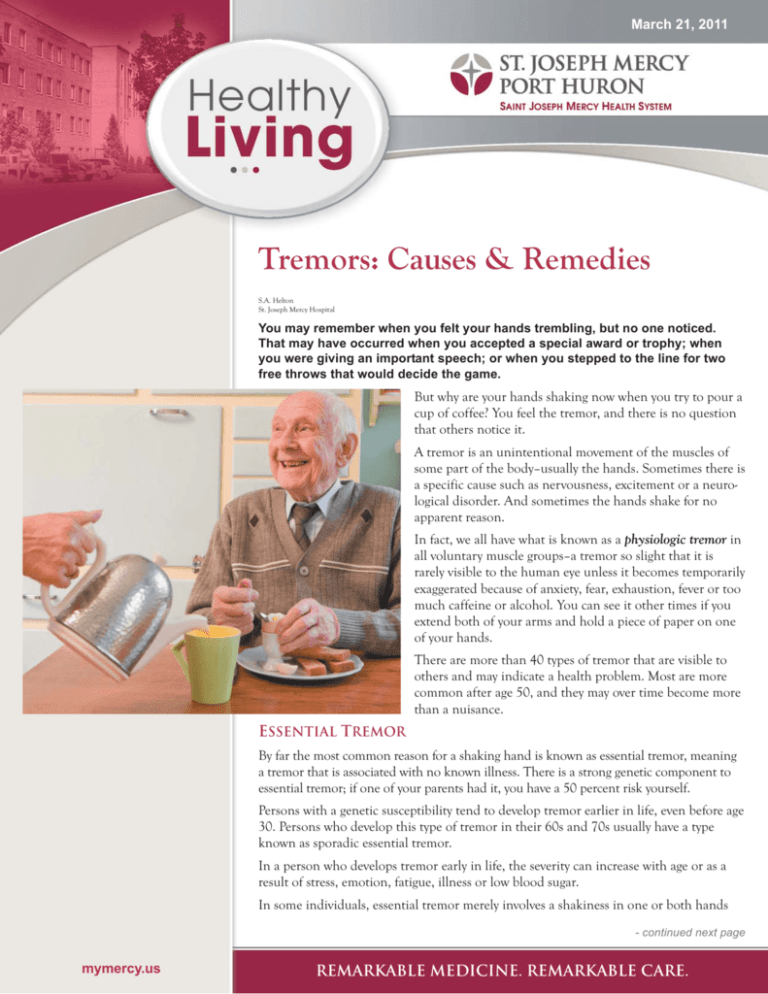
March 21, 2011 Tremors: Causes & Remedies S.A. Helton St. Joseph Mercy Hospital You may remember when you felt your hands trembling, but no one noticed. That may have occurred when you accepted a special award or trophy; when you were giving an important speech; or when you stepped to the line for two free throws that would decide the game. But why are your hands shaking now when you try to pour a cup of coffee? You feel the tremor, and there is no question that others notice it. A tremor is an unintentional movement of the muscles of some part of the body–usually the hands. Sometimes there is a specific cause such as nervousness, excitement or a neurological disorder. And sometimes the hands shake for no apparent reason. In fact, we all have what is known as a physiologic tremor in all voluntary muscle groups–a tremor so slight that it is rarely visible to the human eye unless it becomes temporarily exaggerated because of anxiety, fear, exhaustion, fever or too much caffeine or alcohol. You can see it other times if you extend both of your arms and hold a piece of paper on one of your hands. There are more than 40 types of tremor that are visible to others and may indicate a health problem. Most are more common after age 50, and they may over time become more than a nuisance. ESSENTIAL TREMOR By far the most common reason for a shaking hand is known as essential tremor, meaning a tremor that is associated with no known illness. There is a strong genetic component to essential tremor; if one of your parents had it, you have a 50 percent risk yourself. Persons with a genetic susceptibility tend to develop tremor earlier in life, even before age 30. Persons who develop this type of tremor in their 60s and 70s usually have a type known as sporadic essential tremor. In a person who develops tremor early in life, the severity can increase with age or as a result of stress, emotion, fatigue, illness or low blood sugar. In some individuals, essential tremor merely involves a shakiness in one or both hands - continued next page mymercy.us remarkable medicine. remarkable care. If you have questions about programs and services of St. Joseph Mercy Port Huron, please visit us online at: mymercy.us. To find a physician near you, call toll-free 1-888-MERCYME. Understanding Tremor - continued that is most apparent when they are outstretched or making fine movements. Occasionally, though, the condition gets gradually worse over a three- or four-year period, sometimes involving the head, voice, tongue, legs and trunk as well as the hands. The person may even have a slight gait disturbance. Although there are no health risks, some individuals become severely disabled, and unable to continue jobs that require fine hand movements. Some patients become inhibited about eating, writing or speaking in public. A small amount of alcohol may ease the tremor. Excessive or longterm alcohol use, however, is likely to have the opposite effect. PARKINSONIAN TREMOR A tremor–usually on one side–is frequently an early sign of Parkinson’s disease, a neurodegenerative disorder that effects about one percent of Americans age 60 and over. Tremors associated with Parkinson’s disease most commonly occur when the hand or effected body part is relaxed or at rest. It’s classically seen as a pill rolling motion of the hands, but it may also effect the chin, lips, legs and trunk, particularly when the person is under stress. Generally, this tremor disappears when the hand is moved purposefully. While it may be troublesome, a tremor is usually one of the least disabling symptoms of Parkinson’s disease. Other signs of the disease include rigidity, slow movements, a shuffling gait and reduced arm swing. For reasons unknown, about 20 percent of persons with essential tremor eventually develop Parkinson’s as well. Most experts do not believe there is a cause/effect relationship. ORTHOSTATIC TREMOR These tremors present as rhythmic muscle contractions in the legs and trunk while you’re standing, or otherwise supporting yourself on these muscles. It often occurs to persons waiting in line for an extended period, and they may be able to control the contractions by leaning against a wall or by sitting. Sometimes known as “shaky legs syndrome,” this tremor creates an increased risk of falling. CEREBELLAR OR INTENTION TREMOR This is a slow, broad tremor that occurs at the end of an intended movement such as writing, pressing a button or reaching for an object. The tremor usually goes away when the effected body part is relaxed. This problem is usually caused by damage to the cerebellum of the brain as a result of a - continued next page Page 2 remarkable medicine. remarkable care. If you have questions about programs and services of St. Joseph Mercy Port Huron, please visit us online at: mymercy.us. To find a physician near you, call toll-free 1-888-MERCYME. Tremor: Causes & Remedies - continued stroke, tumor or disease such as multiple sclerosis. It can also be an effect of chronic alcoholism or overuse of some medications. Other manifestations of cerebellar damage could include speech problems; rapid, involuntary rolling of the eyes; an abnormal gait and a tremor of the trunk and neck. TREATMENT Options Join Us... Healthy Aging Seminar Join St. Joseph Mercy Chaplain Sister Kathy Wood, OP, as she explores the joy of laughter in maintaining a healthful lifestyle at: “Laughter: It Really is the Best Medicine”. The event will be held Wednesday, April 20, at 2 p.m., at St. Joseph Mercy Hospital’s Baggot Street Café (cafeteria). To make your reservation to attend, call 1-888-MERCYME (1-888-637-2963). To obtain regular updates, check out St. Joseph Mercy Port Huron on facebook. Unless there is a treatable underlying reason for the tremor, there is ordinarily no cure, but there are numerous ways of managing the condition and overcoming the inconvenience, embarrassment and disability. Essential tremor can usually be relieved, at least in part, by beta blockers. Orthostatic tremor is usually treated with a combination of these types of medications. Parkinsonian tremors are more difficult to manage, but are often treated with drug therapy. Cerebellar tremors usually do not respond to drug therapy. Surgery can be used for certain severe, disabling tremors, but there are far less invasive options such as treatment injections. In the majority of cases, the patient can be helped through physical therapy and lifestyle changes. Adjustments can be made: putting a napkin between a cup and saucer to reduce rattling; learning to write and eat with the hand that does not shake; avoiding foods such as soup and spaghetti when eating out. A physical therapist can help the patient learn to gain control through bracing the effected limb against something or changing positions. Braces, splints, wrist or ankle weights or assistive devices may help. For stress-related tremors, meditation and relaxation therapy may be prescribed. Despite the name often given, essential tremor is by no means benign to the person experiencing it. Although it may help to know that no serious illness is involved, the important task is to reduce the disabling effects. If you suffer from tremors, talk to your doctor today about a treatment option that might be right for you. To find a St. Joseph Mercy physician near you, call toll-free 1-888-MERCYME, or visit us online at mymercy.us. The information provided in Healthy Living is for educational purposes only. Speak with your doctor directly about any issues that effect your health. Editor: Stephanie Armstrong-Helton 810-984-1166 heltons@trinity-health.org mymercy.us Check Us Out St. Joseph Mercy Port Huron has expanded our updates on Facebook. Search us and let us know if you “like” what you see! St. Joseph Mercy Port Huron O 2601 Electric Avenue, Port Huron, MI 48060 O mymercy.us If you have questions about programs and services of St. Joseph Mercy Port Huron, please visit us online at: mymercy.us. To find a physician near you, call toll-free 1-888-MERCYME. mymercy.us St. Joseph Mercy Port Huron O 2601 Electric Avenue, Port Huron, MI 48060 O mymercy.us

